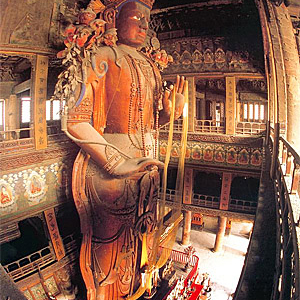Yonghegong Lama Temple
The Yonghegong Lama Temple at the northeast corner of downtown Beijing was originally used as official residence for court eunuchs of the Ming dynasty and was converted to the royal court of Prince Yongzheng during the 33rd year (1693) of Kangxi’s reign of the Qing dynasty. In the 3rd year of Yongzheng’s rein (1725), it was elevated to imperial palace for short stays away from the capital with the name changed to Yonghe Palace of Peace and Harmony. During the 9th year of Emperor Qian Long’s reign (1477), it was change into Lama Temple.
The dimensions of the temple are magnificent, which have five courtyards in a row. The front structural layout in the temple is bright and spacious dotted with screen walls with carved murals, lifeless things and decorated archways. The interior pavement leading to the main halls and the evergreen pine and cypress appear to be rather peaceful and secluded in the environment. The back structural layout is composed of a cluster of building, halls and pavilions intermingled with each other, and upturned eaves and ridges beautifully interwoven presenting a picturesque sight.
Palace of the Heavenly King, Yonghe Palace, Eternal Blessing Hall, the Hall of the Wheel of the Law and Hall of boundless Happiness are the main structures. The Hall of the Wheel of the Law is extremely imposing; the overall arrangement of its plane diagram forms a cross sign and there are five petty garrets on the ceiling decorated with small lama pagodas, which are characterized by the style of lamaism. The Hall of Boundless Happiness is the biggest building in the Lama Temple of Peace and Harmony flanked by the Hall of Everlasting Health and the Hall of Peace. They are connected by a corridor of the Suspension Hall, which form a cluster of majestic dignified buildings. In the Hall of the Boundless Happiness, stands a famous huge statue of Buddha, 26 meters high carved out of a whole piece of sandalwood; it is the biggest wood-carving Buddha in the world.
Most visitors to the temple will burn joss sticks to worship the Buddha. However, it is wise to buy the joss sticks outside. If there are two many pilgrims and you do not have the chance to burn you joss sticks, the lama will ask you to leave them on the sacrifice table. After visiting the Lama Temple, one can also go to the Guozijian and Confucius Temple, which are in the neighborhood of the Lama Temple and of high cultural and historical values.

